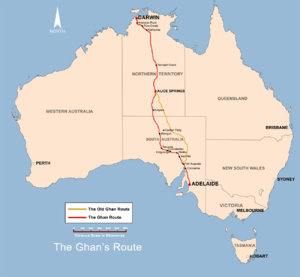The Ghan
|
The Ghan at Alice Springs in July 2015 | |||||
| Overview | |||||
|---|---|---|---|---|---|
| Service type | Transcontinental passenger rail | ||||
| Status | Operating | ||||
| Locale | Australia | ||||
| First service | 1929 | ||||
| Current operator(s) | Great Southern Rail | ||||
| Former operator(s) |
Commonwealth Railways Australian National | ||||
| Route | |||||
| Start | Adelaide | ||||
| End | Darwin | ||||
| Distance travelled | 2,979 km (1,851 mi) | ||||
| Service frequency | Weekly | ||||
| Line(s) used | Adelaide–Darwin railway | ||||
| On-board services | |||||
| Seating arrangements | Yes | ||||
| Sleeping arrangements | Yes | ||||
| Technical | |||||
| Rolling stock | Commonwealth Railways stainless steel carriage stock | ||||
| Track gauge | 1,435 mm (4 ft 8 1⁄2 in) | ||||
| |||||
| The Ghan | |||||||||||||||||||||||||||||||||||||
|---|---|---|---|---|---|---|---|---|---|---|---|---|---|---|---|---|---|---|---|---|---|---|---|---|---|---|---|---|---|---|---|---|---|---|---|---|---|
| |||||||||||||||||||||||||||||||||||||
The Ghan is an Australian passenger train service between Adelaide, Alice Springs and Darwin on the Adelaide–Darwin railway. Operated by Great Southern Rail, it takes 54 hours to travel the 2,979 kilometres (1,851 mi) with a four-hour stopover in Alice Springs.[1]
Etymology
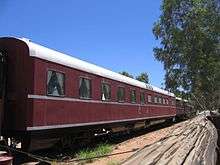
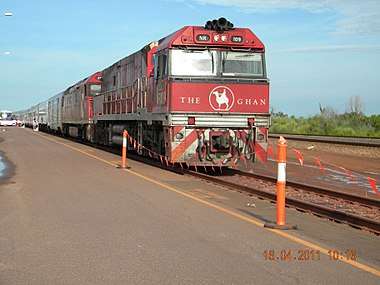
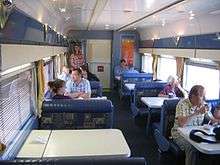
The service's name is an abbreviated version of its previous nickname, The Afghan Express. The nickname is reputed to have been bestowed in 1923 by one of its crews.[2] Some suggest the train's name honours Afghan camel drivers who arrived in Australia in the late 19th century to help the British colonisers find a way to reach the country's interior.[3]
A contrary view is that the name was a veiled insult. In 1891, the railway from Quorn reached remote Oodnadatta where an itinerant population of around 150 cameleers were based, generically called "Afghans". "The Ghan Express" name originated with train crews in the 1890s as a taunt to officialdom because, when an expensive sleeping car was put on from Quorn to Oodnadatta, "on the first return journey the only passenger was an Afghan", mocking its commercial viability.[4] By as early as 1924, because of the notorious unreliability of this fortnightly steam train, European pastoralists commonly called it "in ribald fashion The Afghan Express".[5] By 1951, when steam engines were replaced by diesel-electric locomotives, this disparaging derivation, like the cameleers, had faded away. Modern marketing has completed the name turnabout.
Operations
The Ghan was privatised in 1997 and has since then been operated by Great Southern Rail, initially as part of the Serco Group. GSR was sold to Allegro Funds, a Sydney investment fund, in March 2015.[6]
The train usually runs weekly year-round. During December 2012 and January 2013 it ran only once every two weeks.[1] Until 2016, a second service operated between June and September.[1][7] The train stops at Adelaide, Alice Springs, Katherine and Darwin; the stops at Alice Springs and Katherine allow time for passengers to take optional tours.[8]
Each train has 16 to 26 stainless steel carriages, built by Comeng, Granville, in the late 1960s / early 1970s for the Indian Pacific, plus a motorail wagon.[9] A Pacific National NR class locomotive usually hauls the train, but occasionally other engines assist, such as an AN class or a DL class locomotive.
History
Starting in August 1929, The Ghan ran on the Central Australian Railway, originally built as a 1,067 mm (3 ft 6 in) narrow-gauge railway to Alice Springs. In 1957, the 1,435 mm (4 ft 8 1⁄2 in) standard gauge Stirling North to Marree line opened, and the Ghan was curtailed to operate only north of Marree. In October 1980 the remainder of the line was replaced by a standard gauge line built to the west of the original line. An extension north from Alice Springs to Darwin opened in January 2004.[10]
Original Ghan
Construction of what was then known as the Port Augusta to Government Gums Railway began in 1878 when Premier of South Australia William Jervois broke ground at Port Augusta.[2] The 1,070 mm (3 ft 6 in) line reached Hawker in June 1880, Beltana in July 1881, Marree in January 1884 and Oodnadatta in January 1891.[11] Work on the extension to Alice Springs began in 1926,[12] and was completed in 1929. Until then, the final leg of the train journey was still made by camel.[13]
Although there were plans from the beginning to extend the line to Darwin, by the time the extension to Alice Springs had been completed, The Ghan was losing money and the plans for further extension to Darwin were suspended indefinitely.[14] The original Ghan line followed the same track as the overland telegraph, which is believed to be the route taken by John McDouall Stuart during his 1862 crossing of Australia.[15]
The Ghan service was notorious for delays caused by washouts of the track. A flatcar immediately behind the locomotive carried spare sleepers and railway tools, so passengers and crew could repair the line. The very uncertain service via this route was tolerated because steam locomotives needed large quantities of water, and Stuart's route to Alice Springs was the only one that had sufficient available water.
During World War II the service had to be greatly expanded, putting great pressure on the limited water supplies. As a result, de-mineralisation towers, some of which survive to this day, were built along the track so that bore water could be used. When a new line to Alice Springs was built in the 1970s, the use of diesel locomotives meant that there was far less need for water, thus allowing the line to take the much drier route from Tarcoola to Alice Springs.
The original Ghan was featured in an episode of BBC Television's series Great Railway Journeys of the World in 1980, presented by Michael Frayn.
New line
The original Ghan ran for the last time in 1980,[13] and the Ghan Preservation Society repairs sections of the old narrow gauge track and some of the sidings.[16] In October 1980, a new standard gauge line from Tarcoola to Alice Springs on the Trans-Australian Railway opened, and the train took the form it has today. The new line is approximately 160 kilometres (99 mi) west of the former line in order to avoid floodplains where the original line was often washed away during heavy rain.[13] It was also hoped that the construction of the new line would improve the train's timekeeping.[14]
The modern Ghan has featured in an episode of Channel 5's series Chris Tarrant: Extreme Railways, and the Mighty Trains series.[17] In November 1998, one service per week was extended from Adelaide to Melbourne while from April 1999, the other was diverted to operate to Sydney.[18][19]
Connection to Darwin
Construction of Alice Springs–Darwin line was believed to be the second-largest civil engineering project in Australia, and the largest since the creation of the Snowy Mountains Scheme (built 1949–1974).[20][21] Line construction began in July 2001, with the first passenger train reaching Darwin on 3 February 2004, after 126 years of planning and waiting[22][23] and at a cost of A$1.3 billion.[24]
The Ghan's arrival in Darwin signified a new era of tourism in the Northern Territory,[25] making travel to the region easier and more convenient as well as providing better access to and for Aboriginal communities in the region.[26] The rail link will allow for more freight to travel through the region, leading to a hope that Darwin will serve as another trade link with Asia.[27]
In preparation for the connection to Darwin, one of the locomotives was named after Steve Irwin in a hope that the internationally recognised face of Australia would help promote the new service and tourism to the region.[28]
Incidents
- On 24 October 2002, The Ghan collided with a school bus in Salisbury, South Australia. Four people on the bus were killed, but there were no significant injuries to the Ghan passengers.[29]
- On 12 December 2006, The Ghan collided with a truck at a level crossing and derailed 35 kilometres (22 mi) south of Adelaide River in the Northern Territory. Seven of the 11 carriages came off the tracks. One woman was critically injured, other passengers received only minor injuries. The truck driver involved was arrested, according to the NT police,[30] charged and found guilty[31] of a number of charges related to the accident.
- On 4 March 2007, rain washed out a portion of the track between Darwin and Adelaide River. During the period of repairs, trains terminated at Katherine.[32]
- On 6 August 2007, The Ghan collided with a truck at a level crossing 50 km (31 mi) north of Adelaide in South Australia. Three passengers suffered from shock and minor injuries. The truck driver was temporarily trapped in his vehicle.[33]
- On 6 June 2009, a nineteen-year-old American tourist clung to the outside of The Ghan for two hours and 200 kilometres (120 mi) when he was locked out of the train following a stop in Port Augusta. A technician, Marty Wells, heard his screams and stopped the train.[34]
Gallery
 The Ghan arriving at Darwin station
The Ghan arriving at Darwin station The Ghan at Alice Springs station
The Ghan at Alice Springs station.jpg.png) NR74, painted the livery of The Ghan, leading a freight service
NR74, painted the livery of The Ghan, leading a freight service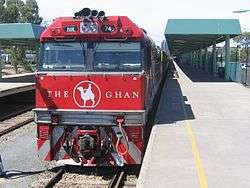 The Ghan at Adelaide Parklands Terminal
The Ghan at Adelaide Parklands Terminal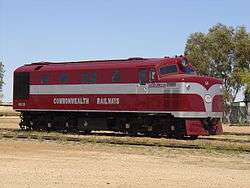 An old Ghan locomotive at the Old Ghan Heritage Railway and Museum in Alice Springs
An old Ghan locomotive at the Old Ghan Heritage Railway and Museum in Alice Springs
References
- 1 2 3 Timetables Great Southern Rail
- 1 2 Barrington R, Babbage J (1980). History of the Pichi Railway. Pichi Richi Railway Preservation Society. ISBN 0-959850-96-1.
- ↑ "Australia: Going, going, Ghan". CNN. 3 March 2004. Archived from the original on 11 September 2007. Retrieved 27 January 2008.
- ↑ News newspaper, 10 July 1937, p. 4.
- ↑ Register newspaper, 20 October 1924, p. 9.
- ↑ South Australia’s iconic train experience The Ghan bought by Sydney investment fund The Advertiser, 30 March 2015. Accessed 31 March 2015.
- ↑ Great Southern Rail to halve services on The Ghan, Indian Pacific after Federal Government cuts ABC News, 6 August 2015.
- ↑ "Want to see more of Australia along the way? Just whistle!", Great Southern Rail website.
- ↑ "History" Archived 2 February 2012 at the Wayback Machine., Great Southern Rail website.
- ↑ A distant dream becomes reality The Age 10 January 2004
- ↑ "Interpreting Beltana's History, interpretative signs around the town". Heritage South Australia, Government of South Australia. 2006. Archived from the original on 19 September 2006. Retrieved 10 September 2006.
- ↑ Mitchell, Barry (26 May 2006). "The Ghan". Australia Wide. ABC 2. Retrieved 27 January 2008.
- 1 2 3 Tregaskis, Moana (16 September 1990). "On the 2 pm from Adelaide to Alice". The New York Times. Retrieved 27 January 2008.
- 1 2 Pfeiff, Margo (5 September 2004). "Slicing Through Australia's Center". The San Francisco Chronicle. Retrieved 27 January 2008.
- ↑ Burton, Rosamund (9 December 2006). "Into the Red". The Australian. Retrieved 28 January 2008.
- ↑ "Alice Springs". The Age. Melbourne. 8 February 2004. Retrieved 28 January 2008.
- ↑ "Watch video online | Discovery". Discovery.ca. Retrieved 2017-08-27.
- ↑ "GSR Announce Changes to Ghan & Overland" Railway Digest August 1998 page 10
- ↑ "Ghan Sydney Bound in April" Railway Digest February 1999 page 12
- ↑ Ian Hammond (1 August 2000). "Work Starts This Month on Alice-Darwin Line". International Railway Journal. Retrieved 16 March 2008.
- ↑ "Tunnels, Dams & Power Stations". Heritage Office News. Heritage Council of NSW. 1998. Archived from the original on 4 March 2012. Retrieved 16 March 2008.
- ↑ "First Train". AustralAsia Railway Corporation. Retrieved 2 February 2016.
- ↑ "About the Ghan". Automobile Association of the Northern Territory. Retrieved 2 February 2016.
- ↑ "Croc Hunter Launches Another Beast". The Age. Melbourne. 25 September 2003. Retrieved 27 January 2008.
- ↑ Barker, Anne (3 February 2004). "International Journalists Cover the Ghan's Journey". The World Today Archive. Retrieved 27 January 2008.
- ↑ "Train Track Opens Awesome Outback". CNN. 1 February 2004. Archived from the original on 19 March 2007. Retrieved 27 January 2008.
- ↑ Squires, Nick (15 January 2004). "Mile-long Train Blazes New Trail Through Parched Heart of Outback". The Telegraph. London. Retrieved 27 January 2008.
- ↑ "Ghan's New 'Steve Irwin' Loco to Bring Tourists to Top End". ABC News. 26 September 2003. Retrieved 27 January 2008.
- ↑ Debelle, Penelope (25 October 2002). "Four Die After Ghan Collides with Packed School Bus". The Age. Melbourne. Retrieved 27 January 2008.
- ↑ "Ghan derailment victim critical". Sydney Morning Herald. AAP. 13 December 2006. Retrieved 13 December 2006.
- ↑ "Court finds Ghan crash driver guilty". National Nine News. 1 December 2007. Retrieved 19 December 2012.
- ↑ "Rains Wash Section of Ghan Rail Link". The Age. Melbourne. 4 March 2007. Retrieved 27 January 2008.
- ↑ "Ghan train smashes into truck". The Age. Melbourne: AAP. 6 August 2007. Retrieved 6 August 2007.
- ↑ Nankervis, David (7 June 2009). "Tourist Chad Vance clung to Ghan train for two hours". news.com.au. Retrieved 12 November 2012.
Further reading
- Agnew, Jonathan (8 December 2013). "Reaching the second Ashes Test the scenic way: Bowling gently to the heart of Australia". MailOnline. Retrieved 2 January 2014.
- Bromby, Robin (2004). Rails to the Top End: The Adelaide-Darwin Transcontinental Railway (4th ed.). Alice Springs, NT: Paul Fitzsimons. ISBN 0958176019.
- Brunhouse, Jay (July 2006). "All Aboard! » New Ghan: out of Darwin". International Travel News]. Retrieved 24 October 2013.
- Cubby, Ben (13 November 2008). "Line dancer". The Sydney Morning Herald. Retrieved 7 May 2014.
- Fuller, Basil (2012). The Ghan: The Story of the Alice Springs Railway. Chatswood, NSW: New Holland Publishers. ISBN 9781742572758.
- Grady, Ian; Fuchs, Don (2007). The Ghan - Australia's Grand Rail Journey: Adelaide to Darwin via the Red Centre and Top End. Winston Hills, NSW: Golden Gecko Press. ISBN 9780980371604.
- Huxley, John (28 September 2016). "On board The Ghan: Travelling Adelaide to Darwin on a luxury train". Traveller.com.au. Fairfax Media. Retrieved 8 January 2018.
- Kellahan, Kristie (13 November 2008). "Of carriages and kings". The Sydney Morning Herald. Retrieved 7 May 2014.
- Lambert, Anthony (7 December 2012). "The Ghan: Great Train Journeys". The Daily Telegraph. Retrieved 24 December 2013.
- Milne, Sue (8 March 2014). "On track for a party". The Australian. Retrieved 9 March 2014.
- Rickard, Lucy (19 June 2012). "Iconic outback train trip". The Sydney Morning Herald. Retrieved 7 May 2014.
- Upe, Robert (4 May 2014). "The Ghan: As good as gold". The Sydney Morning Herald. Retrieved 7 May 2014.
External links

- The Ghan web page
- The Ghan ephemera digitised and held by the National Library of Australia
- The Ghan Australia's Greatest Train Journey 3-hour "Slow TV" documentary by SBS TV, first broadcast 7 January 2018 (video not accessible outside Australia)
| Corridors | |||||
|---|---|---|---|---|---|
| Passenger trains |
| ||||
| Operators | |||||
